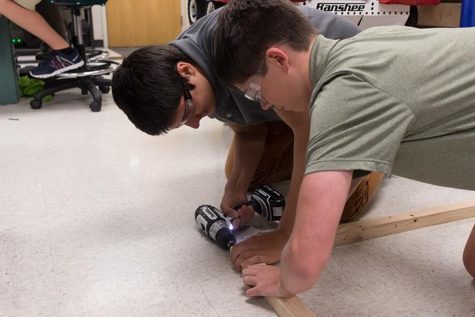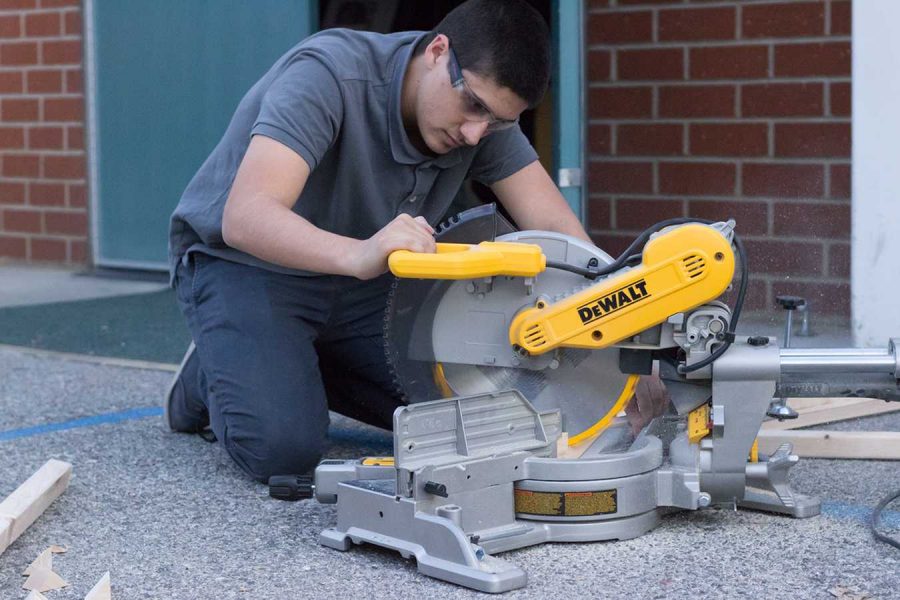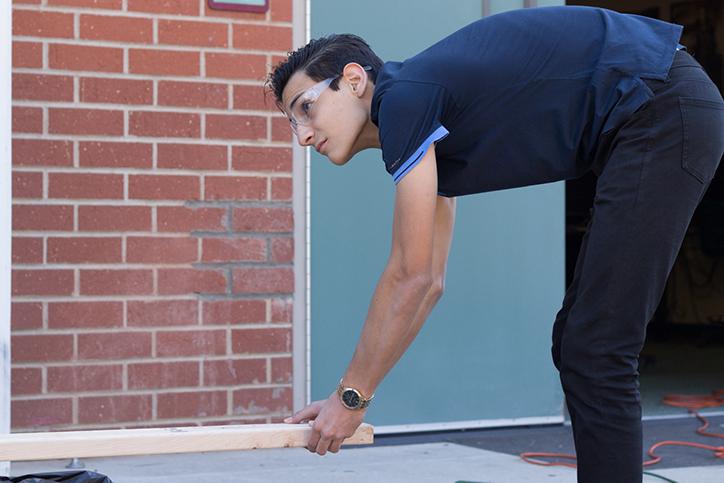Alexander Fenyes cuts wooden plank edges at a forty-five degree angle using Matt Stroup’s portable saw.
Students establish a new ecosystem amongst classes
A collaboration emerges amongst the robotics, engineering and cinematography students through the construction of a cinema tool.
December 2, 2016
Clark Magnet has many unique features when compared to other Glendale Unified high schools, such as its block schedule, relatively small community or the yearlong senior project. A new such feature has recently sprouted among the robotics, engineering and cinematography classes. Students from those courses contributed to a mutually-beneficial project, one that aided the robotics students in filling their class community service hours and one that will open a new range of possibilities for the cinematography classes — building a cyclorama from scratch.
“A cyclorama is pretty much a wall and a floor with a smooth transition in between that is all green,” said Michael O’Gara, one of the robotics students involved in working in this project. “This lets the cinematography team use the green color and change it to a different background.”
Previous to the project, the cinematography class had a simple green screen that students could use to place people or objects into different locations; however, it had a severe limitation. “The problem with the traditional green screen is it does not cover the floor. If you were to attach another green screen you would have dark seams that you would then have to go in postproduction and clear out,” said cinematography teacher Matt Stroup. “You get into issues where you have to get people up off the ground, or you must cut off their legs. It really limits your ability to have a person in an open space and make it look like they’re actually in that space given the perspective of the camera.”

Matt Stroup explains his initial plan for the cyclorama to Alexander Fenyes and Michael O’Gara.
Stroup has been thinking of implementing a cyclorama for a long time, but what really sparked his interest was a conversation he had in the beginning of the school year with robotics and engineering teacher David Black. The robotics class has a requirement for each student to invest four hours into a community service project with an engineering focus. “That happened to come up in conversation and I thought, ‘Hey, this would be a great opportunity to have them design and engineer and then build this cyclorama that we could use in cinema.’ So, then we have this situation where we’re doing this cross pollination with students who have a common interest in both subject matters,” Stroup said.
Stroup spoke with Alexander Fenyes, a cinematography and robotics student, and organized a meeting. Fenyes brought O’Gara along, and the trio developed a plan. The early blueprints were done on paper before being transferred into Autodesk Inventor by O’Gara and Fenyes. With the parts list ready, Stroup came back with his personal trailer and delivered the resources that he purchased using funds from a previous cinematography project done for the Glendale Education Foundation.
This is where the first challenge began. The pieces of wood had to be ripped, meaning cut lengthwise, which neither O’Gara nor Fenyes had done before. After receiving a cautionary warning from their engineering teacher, Black proceeded to teach both O’Gara and Fenyes in the process of ripping wood.
An additional problem was the lack of labor. “It was hard getting enough people to help with the actual project, most of the time it was just myself and Michael,” Fenyes said. To alleviate the trouble, Stroup asked seven students during enrichment to collaborate in the long development of the cyclorama and brought along his portable saws from home.

“My teacher, which I have a lot of respect for, needed help with the construction, so me and my engineering buddies just gathered up and helped him out,” said Bagrat Paronikyan. Paronikyan, along with the other cinematography students who assisted with the project, had previous experience in Black’s engineering classes. “I passed Intro to Engineering last year, so now I’m in regular engineering,” Paronikyan said.
However, some students did not have any engineering experience. Such was the case with Edward Bakchadjian, who decided to help as he thought that the cyclorama would be a great addition to the class. When talking about the various applications of the cyclorama, Bakchadjian used an example of creating a skydiving scene without actually being in the sky. Bakchadjian said that with the cyclorama, one can “pan the camera, going from the floor to the roof and maybe showing a round view” of the actor, allowing for a realistic scene that would not be possible with a simple green screen.
The cyclorama is not yet completed. According to Fenyes, the project should be finished in March. This collaborative work among robotics, engineering and cinematography students has created an ecosystem where the cinematography students earned experience in a large-scale project and contributed to a future upgrade to their equipment and where the robotics and engineering students learned new skills and filled their community service hours. However, the ecosystem is projected to spread even larger than those three classes. “I don’t want to limit the cyclorama to just cinema,” Stroup said.
“In previous years, the robotics team used our green screen to do product shots with their stuff. We have animation, so now [with the cyclorama] you could do something like in Star Wars where you actually build a model ship and manipulate that ship and composite it. So animation can use it. Mr. Zamlich has students from photography, they can come up and do still images and then take that back into Photoshop and key it out. It has a lot of different uses,” Stroup said.

